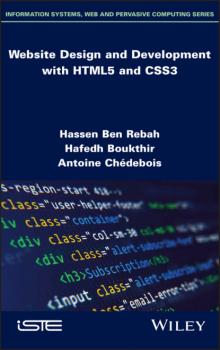John Wiley & Sons Limited
Все книги издательства John Wiley & Sons LimitedEncyclopedia of Renewable Energy
ENCYCLOPEDIA OF RENEWABLE ENERGY Written by a highly respected engineer and prolific author in the energy sector, this is the single most comprehensive, thorough, and up-to-date reference work on renewable energy. The world’s energy industry is and has always been volatile, sometimes controversial, with wild swings upward and downward. This has, historically, been mostly because most of our energy has come from fossil fuels, which is a finite source of energy. Every so often, a technology comes along, like hydrofracturing, that is a game-changer. But is it, really? Aren’t we just delaying the inevitable with these temporary price fixes The only REAL game-changer is renewable energy. For decades, renewable energy sources have been sought, developed, and studied. Sometimes wind is at the forefront, sometimes solar, and, for the last decade or so, there has been a surge in interest for biofeedstocks and biofuels. There are also the “old standbys” of nuclear and geothermal energy, which have both been around for a very long time. This groundbreaking new volume presents these topics and trends in an encyclopedic format, as a go-to reference for the engineer, scientist, student, or even layperson who works in the industry or is simply interested in the topic. Compiled by one of the world’s best-known and respected energy engineers, this is the most comprehensive and up-to-date encyclopedia of renewable energy ever written, a must-have for any library. Encyclopedia of Renewable Energy: Is written in an encyclopedic style, covering every aspect of renewable energy, including wind, solar, and many other topics Offers a comprehensive coverage of the industry, from the chemical processes of biofeedstocks and biofuels to the machinery and equipment used in the production of fuel and power generation Is filled with workable examples and designs that are helpful for practical applications Covers the state of the art, an invaluable resource for any engineer Audience Engineers across a variety of industries, including wind, solar, process engineering, waste utilization for fuels, and many others, such as process engineers, chemical engineers, electrical engineers, petroleum engineers, civil engineers, and the technicians and other scientists who work in this field
Practical Equine Dermatology
A practical and comprehensive reference for equine dermatology cases The newly revised Second Edition of Practical Equine Dermatology delivers a thorough exploration of common dermatological conditions affecting horses whilst also drawing attention to rarer conditions. The book offers detailed advice on treatments and products currently available on the veterinary market in a problem-oriented layout that provides a practical approach to quick and efficient diagnosis. Clinical presentations, diagnostic features, and disorder management for each described condition are presented in an easy-to-digest bullet-point format supported by concise references and recommendations for further reading. An ideal quick reference for veterinary practitioners on the key points of equine skin conditions, this new edition also includes: A thorough introduction to the diagnostic approach, including taking an accurate history, the clinical examination, and diagnostic tests. Comprehensive exploration of pruritus, including contagious conditions, such as ectoparasites and helminth infestation, and non-contagious conditions, such as insect attack and atopic dermatitis. Practical discussion of crusting and scaling, including primary seborrhoea and infectious causes, such as superficial fungal infections and environmental factors. In-depth examination of ulcers and erosions, nodules and swellings, coat problems, and pigmentary disorders. Perfect for any practising veterinarian seeing equine cases in first opinion practice, Practical Equine Dermatology will also be of use to veterinary students with an interest in equine veterinary medicine.
Recording and Voice Processing, Volume 2
Capturing, recording and broadcasting the voice is often difficult. Many factors must be taken into account and achieving a true representation is much more complex than one might think.<br /><br />The capture devices such as the position of the singer(s) or narrator(s), the acoustics, atmosphere and equipment are just some of the physical aspects that need to be mastered. Then there is the passage through the analog or digital channel, which disrupts the audio signal, as well as the processes that are often required to enrich, improve or even transform the vocal timbre and tessitura. While in the past these processes were purely material, today digital technologies and software produce surprising results that every professional in recording and broadcasting should know how to master.<br /><br /><i>Recording and Voice Processing 2</i> focuses on live and studio voice recordings. It presents the various pieces of hardware and software necessary for voice recording, and details possible sound channel configurations based on recording location. An actual recording, and its various constraints, is then considered, addressing the pitfalls to avoid and the strategies to use in order to achieve a satisfactory result. Different special effects (vocoder, auto-tune, Melodyne, etc.) that can be used on the voice, whether spoken or sung, are also presented.
Cindynics, The Science of Danger
This book offers a new perspective to uncover the keys to accident and disaster avoidance. Created with a working group, it presents research and understanding on the root causes of disasters. Indeed, beyond technical failures, human beings are at the heart of organizations and, through the exchange of data and information, influential relationships inevitably emerge such as conflicts of interest and cooperation.<br /><br />With examples selected from multiple accidents and disasters, this book demonstrates that analyzing the causal chain that leads to an accident is not sufficient if we wish to truly understand it. The role of operational and managerial actors and the complexities they generate are also explored.<br /><br /><i>Cindynics, The Science of Danger</i> helps readers develop their ability to identify gaps, deficits, dissonances, disjunctions, degenerations and blockages, which are the real dangers in inevitably evolving activity situations. With an easily-understandable approach, this book offers new perspectives in several fields (health, crisis management and conflict resolution).
Deterministic Numerical Modeling of Soil Structure Interaction
In order to describe soil–structure interaction in various situations (nonlinear, static, dynamic, hydro-mechanical couplings), this book gives an overview of the main modeling methods developed in geotechnical engineering. The chapters are centered around: the finite element method (FEM), the finite difference method (FDM), and the discrete element method (DEM). Deterministic Numerical Modeling of Soil–Structure Interaction allows the reader to explore the classical and well-known FEM and FDM, using interface and contact elements available for coupled hydro-mechanical problems.<br /><br />Furthermore, this book provides insight on the DEM, adapted for interaction laws at the grain level. Within a classical finite element framework, the concept of macro-element is introduced, which generalizes constitutive laws of SSI and is particularly straightforward in dynamic situations. Finally, this book presents the SSI, in the case of a group of structures, such as buildings in a town, using the notion of metamaterials and a geophysics approach.









